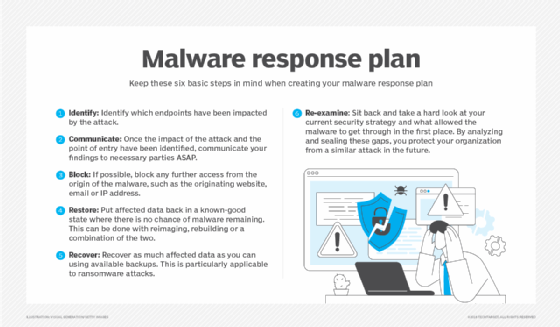
Alex - stock.adobe.com
How to avoid and remove malvertising
Malvertising is an up-and-coming cybersecurity threat, but marketing and IT teams alike can take several important steps to avoid and remove this threat.
Cybersecurity breaches can significantly damage a company's reputation and finances if compromised through an attack, making it a critical aspect of modern business operations.
Malware is a major cybersecurity threat. This program infiltrates and damages computer systems without consent. Common forms include viruses, worms, Trojans, ransomware and spyware, each capable of compromising data integrity, privacy and system functionality. Traditionally, malware spreads through infected email attachments, compromised software downloads and malicious websites. However, cybercriminals have increasingly exploited online ads to distribute malware, leading to the emergence of malvertising.
Malvertising involves embedding malicious code within legitimate-looking online ads. These ads get distributed across reputable websites through legitimate ad networks, so both users and publishers struggle to detect the threat. When users encounter a compromised ad, it can redirect them to harmful websites or install malware on their devices without any interaction. This tactic uses the extensive reach of online advertising to broadly disseminate malware.
For sales and marketing leaders, malvertising poses significant concerns. It can erode consumer trust, damage a brand's reputation and lead to financial losses. Users who encounter malicious ads on a company's platform might associate the brand with security risks, resulting in decreased engagement and potential customer attrition.
Additionally, organizations could face legal liabilities if found negligent in protecting users from such threats. Therefore, sales and marketing teams must take proactive measures, educate customers and offer resources to mitigate malvertising risks. Proactive measures include effective security protocols, regular audits for ad content and more user awareness about safe online practices.
With these strategies to avoid and remove malvertising, organizations can protect customers and uphold brand integrity.
1. Adopt the right antivirus software
Reliable antivirus software can detect and neutralize threats like malvertising. These programs offer real-time protection against various types of malware, including ransomware, spyware and adware, which often accompany malvertising attacks.
Business leaders should work closely with IT teams to evaluate and select software tailored to their organizational needs. Features like automatic updates, comprehensive scanning and heuristic analysis should guide purchasing decisions. If a business doesn't already have antivirus software, it must allocate budget for this tool.
Advantages of adopting antivirus software include the following:
- Real-time threat detection and prevention.
- Protection against a broad range of malicious software.
- Automatic updates to stay ahead of emerging threats.
2. Regularly clear browser cache
Browser caches store website data to improve loading times, but they can also retain harmful scripts or cookies that malvertising plants. Users who regularly clear their caches can eliminate residual threats and prevent their exploitation.
Marketing leaders can collaborate with IT departments to develop automated cache-clearing policies or educate users on manual clearing methods. This practice should be part of broader cybersecurity training sessions to ensure consistent adoption across the organization.
Advantages of clearing browser cache include the following:
- Removes stored malware scripts and tracking cookies.
- Removes outdated cached data to improve browser performance and speed up browsing.
- Reduces risk of repeat infections.
3. Check and remove suspicious apps
Malvertising can infiltrate devices through fraudulent or unauthorized apps, which might appear legitimate. Business leaders must establish guidelines for app usage to ensure employees download software only from verified sources.
IT departments should conduct regular audits to identify and remove unapproved or suspicious apps. Additionally, training sessions can help users recognize warning signs of malicious apps and reinforce secure downloading habits. When necessary, IT teams should consider deploying mobile device management software to control and monitor app installations.
Advantages of app audits and removals include the following:
- Minimizes vulnerabilities from unapproved software.
- Reduces the attack surface of malvertising, as businesses would have fewer apps that could be vulnerable to the scripts.
- Promotes a culture of safe technology and app usage.
4. Use browser security settings
Most modern browsers include security features, such as pop-up blockers, antitracking tools and sandboxing to isolate malicious activities.
Business leaders can work with IT teams to standardize these settings across the organization and ensure they remain current. They should also train employees to recognize security alerts on browsers and avoid overriding warnings.
IT teams can also deploy enterprise browser tools that enforce compliance with security protocols at a larger scale. Customers can activate security settings within their own browsers to ensure they are active while browsing.
Advantages of enhanced browser security settings include the following:
- Mitigates threats from third-party pop-ups and website trackers.
- Reduces user dependency on manual threat detection.
- Aligns browser behavior with organizational security policies and consumer best practices.
5. Educate users about malvertising
Education is one of the most effective ways to combat malvertising. Users who understand how malicious ads operate are less likely to fall victim to such tactics.
Companies should prioritize regular training sessions that teach employees to identify suspicious ads and websites. Real-life examples of malvertising attacks can make training relatable and memorable. Additionally, organizations should offer customers accessible resources, such as guides and webinars, to promote safe online practices.
Advantages of user education include the following:
- Empowers users to recognize and avoid threats.
- Reduces the success rate of malvertising attacks.
- Builds trust and improves engagement with customers.

6. Partner with reputable ad networks
Organizations that work with well-vetted ad networks can significantly reduce the risk of malvertising. Reputable networks conduct rigorous ad screening and deploy advanced tools to detect malicious content.
Marketing leaders should carefully evaluate ad partners and prioritize those with advanced security measures and transparent policies. Regular reviews of campaign performance reports can also help detect anomalies indicative of malvertising attempts.
To assist with customer trust, the marketing team can regularly release updates to their advertising practices and build awareness around what the company does or does not do with ad platforms. So, when customers see something that doesn't align with those practices, they can avoid those ads.
Advantages of reputable ad network partnerships include the following:
- Enhances customer trust in hosted ads.
- Reduces liability from malvertising-related incidents.
- Ensures higher-quality ad placements.
7. Conduct regular security audits
Proactive security audits identify vulnerabilities in an organization's digital infrastructure that malvertising can exploit. These audits should encompass a review of ad content, third-party integrations and system defenses.
Business leaders should allocate resources to hire external cybersecurity experts or bolster internal teams to conduct comprehensive assessments. Findings from audits should guide strategic investments in technology and policy improvements to address identified gaps. Additionally, companies must inform customers about these audits and highlight the steps the company takes to follow cybersecurity best practices.
Advantages to regular security audits include the following:
- Uncovers hidden vulnerabilities.
- Provides actionable insights to improve defenses.
- Demonstrates commitment to security to internal stakeholders and the external customer base.
These proactive steps empower business leaders to protect their organizations and customers from the growing threat of malvertising. Businesses that integrate technology, training and strategic partnerships can minimize exposure to this threat and reinforce trust and security in their online engagements.
Griffin LaFleur is a MarketingOps and RevOps professional working for Swing Education. Throughout his career, LaFleur has also worked at agencies and independently as a B2B sales and marketing consultant.







